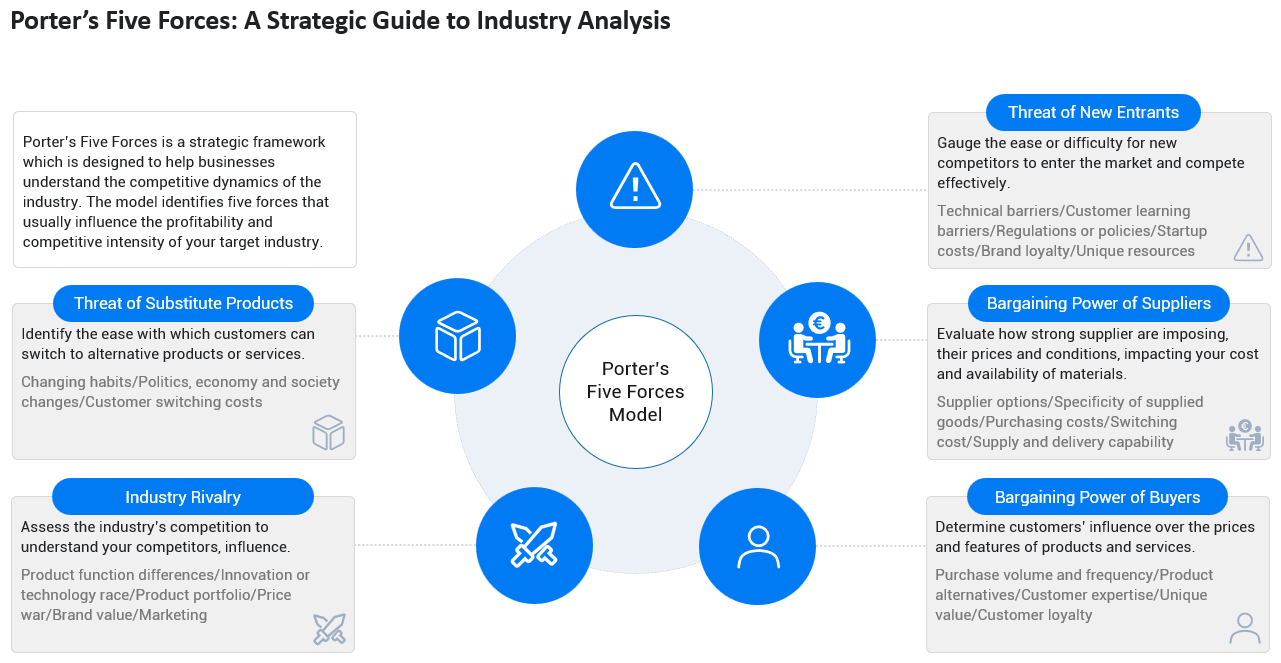A strategic lens that reveals the competitive dynamics shaping any industry.
Introduction
Porter's Five Forces is a strategic framework developed by Michael E. Porter, a professor at Harvard Business School. He introduced it in his 1979 book Competitive Strategy: Techniques for Analyzing Industries and Competitors.
It is designed to help businesses understand the competitive dynamics of their industry and make better strategic decisions. The model identifies five forces that usually influence the profitability and competitive intensity of your target industry.
These forces help you see who holds power, where potential threats lie, and which opportunities you can tap into.
The Five Forces: Breaking Them Down
Let’s explore each of the five forces and understand how they shape your industry. These forces work together like pieces of a puzzle, giving you a full picture of your competitive environment.
Threat of New Entrants
This force is all about the likelihood of new players entering your market. Gauge the ease or difficulty for new competitors to enter the market and compete effectively.
Factors to Consider:
- Technical barriers
- Customer learning barriers
- Strict regulations or policies
- High startup costs
- Strong brand loyalty
- Unique resources
When barriers to entry are low, it’s easier for competitors to jump in and share the profits, please expect increased competition and tighter profit margins.
Bargaining Power of Suppliers
Suppliers are the backbone of your operations, providing the resources you need to create your products or services. Evaluate how strong supplier are imposing their prices and conditions, impacting your cost and availability of materials.
Factors to Consider:
- Supplier options (the more options you have, the stronger position to negotiate favorable deals)
- Specificity of supplied goods
- Purchasing costs
- Switching cost
- Supply and delivery capability
Bargaining Power of Buyers
This force examines how much influence your customers have over your products and services.
Factors to Consider:
- Purchases volume and frenquecy
- Product alternatives
- Customer expertise
- Unique Value (tangible and intangible)
- Customer loyalty
If there are many alternatives in the market or if your buyers are highly price-sensitive, they can push you to lower prices. However, offering unique value or creating loyal customer relationships can help you reduce their bargaining power.
Threat of Substitute Products or Services
Substitutes are alternatives that solve the same problem for your customers. So this force is to identify the ease with which customer can switch to alternative products or services.
Factors to Consider:
- Changing habits
- Politics, economy and society changes
- Customer switching costs
If substitutes are more affordable, convenient, or innovative, you risk losing market share. Identifying and differentiating your offering can help you stay ahead of substitutes and retain customer loyalty.
Industry Rivalry
Assesses the intensity of competition and understand your competitors' influence in your market.
Factors to Consider:
- Product function differences
- Innovation or technology race
- Product portfolio
- Price war
- Brand value
- Marketing
Summary
Porter’s Five Forces serves as a lens to "zoom out" and view not only your direct competitors but the broader dynamics shaping your business landscape. It’s like mastering the "rules of the game" in your industry, enabling you to compete with sharper focus and smarter strategies.
By understanding these forces, you will gain the strategic insight needed to navigate your industry effectively, uncover growth opportunities, and protect your competitive position.
Template
Get into the real practice now.






